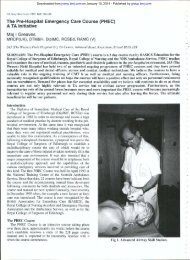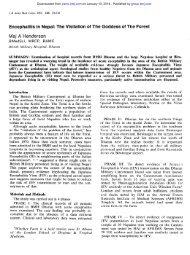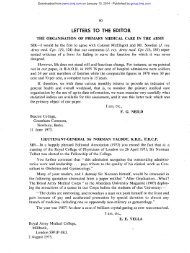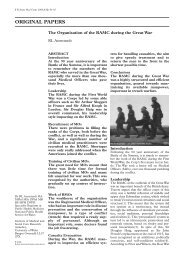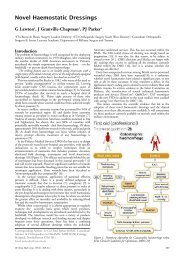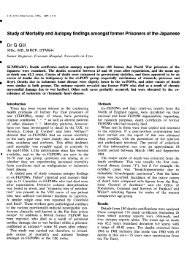JDC Bennett, J Bezzina. Dr George Adam. - Journal of the Royal ...
JDC Bennett, J Bezzina. Dr George Adam. - Journal of the Royal ...
JDC Bennett, J Bezzina. Dr George Adam. - Journal of the Royal ...
Create successful ePaper yourself
Turn your PDF publications into a flip-book with our unique Google optimized e-Paper software.
Downloaded from jramc.bmj.com on January 10, 2014 - Published by group.bmj.com<br />
J R Army Med Corps 1992; 138: 49<br />
Or <strong>George</strong> Mc<strong>Adam</strong><br />
Maj J D C <strong>Bennett</strong><br />
BSc, FRCS, DCH, DHMSA, FSA, RAMC<br />
Senior Specialist in Otolaryngology<br />
Queen Elizabeth Military 1I0.'pital, Woolwich, London SEJ8 4QH<br />
<strong>Dr</strong> J <strong>Bezzina</strong><br />
Dip Arch, Dip Bibl, BA HED<br />
Lecturer<br />
Faculty <strong>of</strong> Theology University <strong>of</strong> Malta<br />
A hi<strong>the</strong>rto little known army surgeon has been commemorated<br />
by having a street in Oozo named after him<br />
for his work during <strong>the</strong> epidemic <strong>of</strong> plague 1813-14 in<br />
Malta. History records quite a few distinguished military<br />
medical men but <strong>the</strong>y are acknowledged or remembered<br />
in o<strong>the</strong>r ways. Military prowess and valour bring<br />
medals - in which field <strong>the</strong> <strong>Royal</strong> Army Medical Corps<br />
and its predecessors are well represented. O<strong>the</strong>rs, such<br />
as BTUce, may be immortalised by having <strong>the</strong>ir discovery<br />
named after <strong>the</strong>m. <strong>George</strong> Mc<strong>Adam</strong>'s work fell into<br />
nei<strong>the</strong>r <strong>of</strong> <strong>the</strong>se categories, but never<strong>the</strong>less, <strong>the</strong> Street<br />
Naming Committee <strong>of</strong> Gozo decided to show gratitude<br />
for his work in <strong>the</strong> early nineteenth century by naming a<br />
street aner him in 1991.<br />
The Mallese archipelago consists <strong>of</strong> three islands<br />
known from north to south as Gozo, Comino and Malta.<br />
They passed informally under British protection on<br />
5 · September 1800. Lying at <strong>the</strong> centre <strong>of</strong> <strong>the</strong><br />
Mediterranean trade routes <strong>the</strong>y had immense strategic<br />
value, but this unfortunately meant that despite quarantine<br />
measures <strong>the</strong> large number <strong>of</strong> ships calling at <strong>the</strong><br />
Grand Harbour brought <strong>the</strong> bubonic plague which had<br />
broken out in Constantinople in 18] 2. From <strong>the</strong>re <strong>the</strong><br />
infection soon passed to Gozo, it was thought through<br />
<strong>the</strong> unwitting carriage <strong>of</strong> a present <strong>of</strong> silk.<br />
Communications between Gozo and Malta were<br />
promptly cut <strong>of</strong>f and a military detachment was sent to<br />
provide a cordon around <strong>the</strong> infected vil1age <strong>of</strong> Xaghra.<br />
Despite <strong>the</strong>se precautions <strong>the</strong> plague spread and it was<br />
decided by <strong>the</strong> government that a manor house be requisitioned<br />
and converted into a hospital.<br />
This took place under a military doctor, <strong>George</strong><br />
Mc<strong>Adam</strong>, who despite <strong>the</strong> known risks had volunteered<br />
for <strong>the</strong> job. He had been commissioned as an Assistant<br />
Surgeon to <strong>the</strong> 24th <strong>Dr</strong>agoons in 1797, to be retired in<br />
1799. He returned to <strong>the</strong> colours in 1802 and was promoted<br />
to Surgeon in 1805, becoming Physician to <strong>the</strong><br />
Forces in 1813. The Tal-Fewdu plague hospital was situated<br />
on <strong>the</strong> outskirts <strong>of</strong> Xaghra and completed by 19<br />
March 1814, less than three weeks after <strong>the</strong> first plague<br />
deaths on <strong>the</strong> island. On Mc<strong>Adam</strong>'s advice a tented<br />
camp was also set up. On 31 March people living in <strong>the</strong><br />
Fig 1. Commemoration street Dame plate (tabib =<br />
doctor)<br />
houses <strong>of</strong> known victims were moved <strong>the</strong>re for observation.<br />
Ano<strong>the</strong>r area was enclosed for <strong>the</strong>ir cattle and<br />
o<strong>the</strong>r animals and <strong>the</strong> whole area sealed by a military<br />
cordon. Unfortunately Mc<strong>Adam</strong>, whose duties lead him<br />
to move freely about in contact with patients, fell prey<br />
to <strong>the</strong> disease and died on 5 May 1814. However <strong>the</strong><br />
plague remained localised to <strong>the</strong> village <strong>of</strong> Xaghra. The<br />
last death was on <strong>the</strong> 28 May and by 14 September<br />
communications between Gozo and Malta were<br />
restored.<br />
In his work at <strong>the</strong> village <strong>of</strong> Xaghra he put into practical<br />
use his organisational capacity drawing on military<br />
resources. Ra<strong>the</strong>r than judging his work from <strong>the</strong> current<br />
standpoint <strong>of</strong> medical knowledge. let us consider it<br />
in its historical context. Much <strong>of</strong> current medical opinion<br />
at <strong>the</strong> time lay with <strong>the</strong> miasma <strong>the</strong>ory <strong>of</strong> disease. It<br />
was considered that diseases emanated from an<br />
"infected atmosphere'. O<strong>the</strong>rs held that plague was a<br />
contagious disease. However contagion was traced to<br />
<strong>the</strong> most astonishing circumstances - for example<br />
through a pair <strong>of</strong> new shoes which had not been hung<br />
for a fortnight before being worn. A total <strong>of</strong> 104 villagers<br />
died during <strong>the</strong> plague <strong>of</strong> 1814 but <strong>the</strong> work <strong>of</strong><br />
Mc<strong>Adam</strong> has been commemorated in 1991 by a Xaghra<br />
street being named after him (Fig 1).
Downloaded from jramc.bmj.com on January 10, 2014 - Published by group.bmj.com<br />
<strong>Dr</strong> <strong>George</strong> Mc<strong>Adam</strong><br />
J D C <strong>Bennett</strong> and J <strong>Bezzina</strong><br />
J R Army Med Corps 1992 138: 49<br />
doi: 10.1136/jramc-138-01-15<br />
Updated information and services can be found<br />
at:<br />
http://jramc.bmj.com/content/138/1/49.citation<br />
Email alerting<br />
service<br />
These include:<br />
Receive free email alerts when new articles cite<br />
this article. Sign up in <strong>the</strong> box at <strong>the</strong> top right<br />
corner <strong>of</strong> <strong>the</strong> online article.<br />
Notes<br />
To request permissions go to:<br />
http://group.bmj.com/group/rights-licensing/permissions<br />
To order reprints go to:<br />
http://journals.bmj.com/cgi/reprintform<br />
To subscribe to BMJ go to:<br />
http://group.bmj.com/subscribe/



